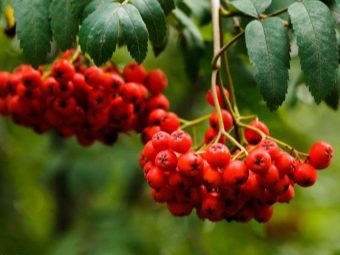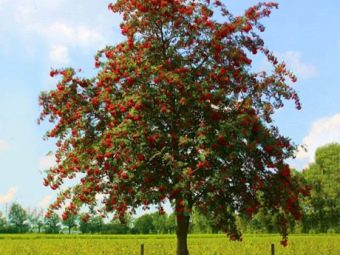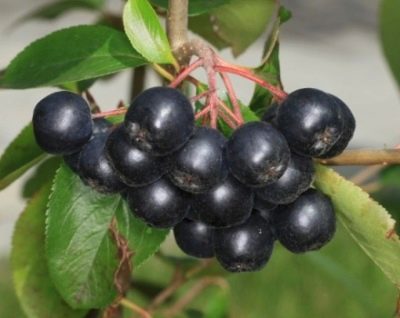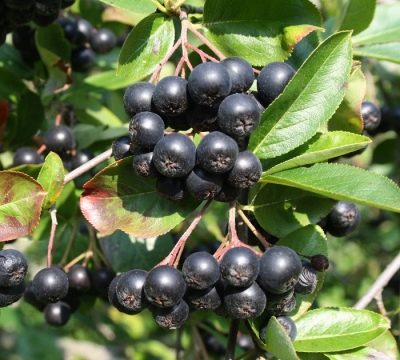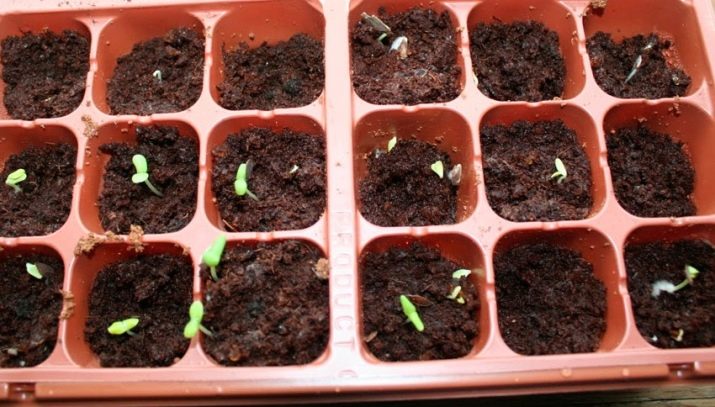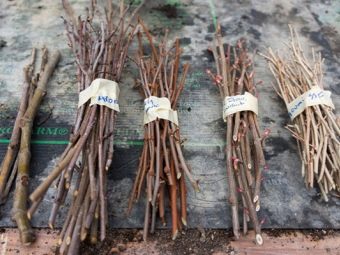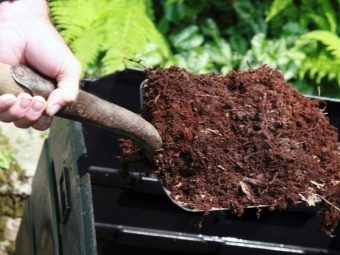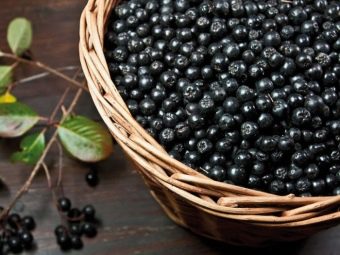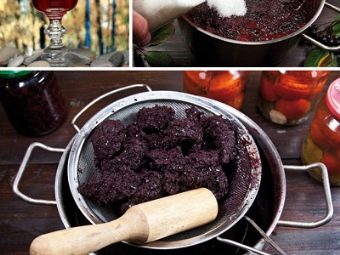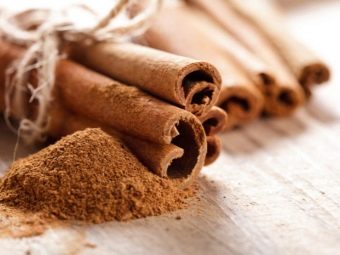Description of black chokeberry: useful properties and growing plants
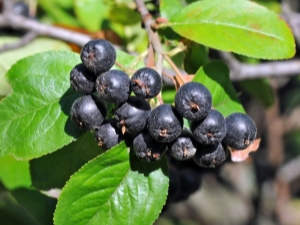
After the onset of the first frost ripen black chokeberry berries. If there is room left in the refrigerator, then the best option for filling it will be these fruits. Useful qualities lie in dark ruby juice, which indicates the full ripening of the berries. Harvesting for the winter can begin with the preparation of jam, and with the manufacture of strong wine.
What is this plant?
Chokeberry Aronia is an alternative Latin name for chokeberry. Description of the similarity of the berries with the fruits of mountain ash gave rise to the main name. The plant is a perennial fruit shrub with a branched root system. Each year at the base of the plant gives root shoots, so that it actively reproduces as independent from each other shoots.
The leaves have a heart-shaped, ending with a sharp tip. Their sizes are due to the variety of the plant, capable of reaching 8 cm in length. In summer, the leaves have a dark green tint, and with the arrival of autumn are colored in purple-red. Leaf venation net.
The flowering period lasts from May to June with five-petal flowers of white and pinkish-white shades. Complex inflorescences have a diameter of 6 cm, reborn into fruits up to 8 mm in size. They begin to ripen in mid-August, becoming purple-black berries with a matte dense skin.
The birthplace of the black insects is the east of the North American continent. In the nineteenth century, the seeds of aronia were brought to Europe, from where the shrubs spread throughout Russia. The wild plant is considered a weed, whereas the domesticated plant is a hybrid species with the active participation of I. V. Michurin. Places of black chokeberry spread throughout the greater territory of the Russian Federation.
Unlike rowan
Aronia came from America at the beginning of the last century. However, the resemblance of plants with rowan is limited only by the Rosy family.
Rowan represents a full-fledged tree, while black chokeberry is a shrub with wide, beautiful, rounded leaves that branches strongly and quickly spreads around the area. The cultivated chernoplodka appeared due to numerous experiments of I. V. Michurin, standing out among the wild relative by the decorative form of leaves and large flowers.
Black chokeberry has a tart taste, astringent tongue. The fruits of mountain ash are much sweeter and do not give enhanced sour taste. Also blackflood prevails over rowan in terms of yield and winter hardiness. Aronia is able to survive in the temperature regime below -40 degrees.
Benefit and harm
Medicinal properties allowed aronia to get into the list of medicinal plants in 1961. Berries contain vitamin P - rutin, which slows down the aging process of the body. The content of macro-and microelements, pectin and vitamin-like substances is also increased.
Useful qualities of chokeberry:
- Lowers cholesterol.
- Normalizes the cardiovascular system due to the high content of potassium. Macroelement increases the tone of the heart muscle and prevents the development of edema. Aronia berries strengthen the walls of blood vessels, which allows them to be used when capillaries are damaged as a preventive measure.
- The chernoplodka contains a complex of vitamins (C, E, B1, B12). It strengthens the immune system and reduces the risk of hypovitaminosis.
- Hypertension is no longer scary. Juice of berries reduces blood pressure by increasing the tone of blood vessels, has a diuretic effect.
- Treatment of diseases of the thyroid gland often requires the use of iodine. In areas remote from the sea, this chemical element is rare. Therefore, doctors recommend taking an additional juice of chokeberry berries because of the increased iodine content.
Reviews of the use of fruits of chokeberry are mostly positive and can compensate for the harm from the abuse of berries in particular cases.
Black fruit berries have contraindications:
- phlebeurysm;
- constipation;
- angina pectoris;
- rehabilitation period after a stroke or heart attack;
- thrombophlebitis;
- low blood pressure.
Berries stimulate the production of hydrochloric acid in the stomach, which allows people with weak acidity of the gastric juice to take them. At the same time, the fruits of chokeberry are categorically prohibited to use in the presence of ulcerative and erosive diseases of the gastrointestinal tract.
What are the varieties?
A wild plant is considered a weed, the fruits of which are practically not suitable for cooking. The bush grows in hard to reach places. Over time, gardeners found that aronia is easy to hybridize. The domesticated shrub began to spread not only in the northern, but also in the southern regions. The number of varieties has increased dramatically:
- Variety "Hugin" designed for decorative use due to tallness. The branches reach a height of 2 meters. The plant tolerates a harsh winter.
- "Nero" possesses the largest berries and is popular as an ornamental plant with wide leaves. The bush is characterized by a high degree of frost resistance and the ability to grow in the shade.
- Resistant to temperature changes "Viking" has large fruits that exceed the size of black currant.
A special place is occupied by the variety "Chernookaya" due to its unpretentiousness to the soil composition and resistance to insect pests. The plant bears berries with a sweet and sour taste.
How to multiply?
Chokeberry Aronia breeds in various ways:
- cotyledons;
- cuttings (woody and green);
- split bush;
- root processes;
- layering (vertical, horizontal, with the formation of an arc);
- grafting;
- inoculation.
A significant advantage is seed reproduction among fruit shrubs. Cultivation begins with the preparation of ripe seeds. They are sifted through a sieve, and then soaked in water.
Rinsing will ensure the separation of seeds from unwanted pulp. To save, you need to mix with river sand in the ratio of 1: 3. The mixture is placed in a refrigerator for 3 months.
Sowing is carried out in the spring - at this time the soil is warming enough. It is previously recommended to loosen the ground by making furrows up to 8 cm deep. The sowing area is required to be mulched. It is necessary to thin the crops when the first two leaves appear.
Distribution of blackfruit cuttings
The second most popular is the breeding method of woody and green cuttings:
- Harvesting woody cuttings from 2-4 summer branches are carried out in the autumn (preferably in October). The length of one cutting should be up to 20 cm in the presence of 4-7 eyes. Landing parts should be carried out at an acute angle (approximately 45 degrees). At the same time on the surface should be left 2 shoots.
- The spread of chokeberry with green cuttings is necessary in conditions of strict temperature conditions - t should be 20 degrees. The billets should be 15 cm in size. The upper leaves should be shortened by ⅓ part, while the lower ones should be completely removed. Before planting, prepared cuttings should be immersed in a special solution to stimulate the root system. Sowing is done at an inclination of 45 degrees.
Cold greenhouses prepare in June. Washed coarse sand with a thickness of 7-10 cm is poured into the loosened layers of clean soil.
Cutting a bush is easy
To transplant a bush black worm to a new place, the best option would be to divide the bush. To do this, the bush must dig and free the root system from the soil. Rotten or damaged root shoots are recommended to be removed.
The bush is divided into the required number of parts. The division into daughter bushes is carried out if each part has at least two strong shoots.For the prevention of infection, the area of cuts is recommended to sprinkle with charcoal.
Root offspring as natural breeding
The fertility of the soil determines the development of poor or rich root system in chokeberry. In the first case, the root scions will become visible around the shrub, which in a year will become an independent plant. Due to this phenomenon, they are cut off from the mother bushes and transplanted to a prepared place.
Reproduction using layering
With the method of reproduction using cuttings, it is necessary to select three branches in the summer season. Under them it is required to dig furrows up to 10 cm deep. Selected branches are laid in prepared pits, after which they are fixed in place with earth. For additional mounting, you can use brackets or other structures.
New shoots will appear from the buds, while the buried part will form a separate root system. A year later, the shoots are disconnected from the parent shrub and transplanted to a new location.
To speed up the process, experienced gardeners make notches in front of the buried part. Less nutrients will flow into the detached branches, which will be an additional stimulation to the formation of a new root system.
Planting and care
A suitable season for planting aronia is the autumn season. Professional gardeners are able to achieve optimal growth during the spring period.
The time frame for planting plants:
- autumn season - from late September to mid-October;
- in spring - from the beginning of March to the end of April.
Chokeberry seedlings are unpretentious to the site for planting and the percentage of humus in the soil. Sprouts sprout on both nitrogen-rich and dry ground. To select a site for planting, it is important to avoid a soil area with a high salt content.
The best option is loamy ground under good lighting with a high moisture content. It is important to remember that the root system of aronium penetrates to a depth of 1 m. The proximity of groundwater does not prevent planting.
Acquire seedlings recommended in specialized stores. To avoid buying plants with defects:
- Before purchasing, you need to inspect the roots for the presence of dried, cracked areas.
- The root system must have at least two large branches.
- The length of the root processes should reach 30 cm.
- When a dry area appears, it is necessary to place it in water for 3 days.
Looking under the bark cut, you can determine the quality of the seedling. With a green cut, you can safely buy a live plant. Brown color means quick death of chokeberry from drying out.
Preparing a pit for planting
Cloudy weather or evening time is suitable for planting seedlings. Single shrubs are recommended to be planted at a distance of about 5 meters from other plants. Otherwise, root systems will intertwine with each other, interfering with the transplant and competing for nutrients in the soil.
For proper preparation of the landing pit should follow the instructions:
- The parameters of the pit must comply with the parameters 50x50x50.
- To fill the holes, it is necessary to prepare fertile soil in advance. 150 g of superphosphate should be added to the excavated earth, a bucket of humus and wood ash weighing 300 g. One third of the pit is filled with the mixture.
- Above the fertile soil poured the usual land to half a planting pit. From above it is poured with a bucket of water. While the water is absorbed, it is necessary to prepare seedlings - the roots are dipped into the clay mixture.
- The plant is set in the center of the pit, straighten the roots and fall asleep with fertile soil. In this case, the root neck should go underground to a depth of 2 cm.
After planting, the soil must be moistened with another bucket of water. Pristvolny circle filled with humus or resin.
Care
Aronia Aronia needs frequent watering, especially during the growth of the plant and the formation of fruits. For proper watering, it is necessary to construct earthen trenches around the plant at a distance of 30-40 cm. It is recommended to water the chokeberry in the evening at the rate of 2-3 buckets per plant. A decrease or increase in the amount of added moisture is produced depending on the age of the black wolf. To ensure optimum moisture penetration, it is recommended to loosen the soil after watering.
To obtain a rich harvest, as well as to support the ornamental appearance of chokeberry chokeberry, additional fertilizing is required. The amount of fertilizer depends on the quality of the soil composition and the percentage of humus. With growth in a favorable place, only one additional feeding in spring can be carried out. For poor soil, the specialists developed the following fertilizer plan:
- The autumn season requires for a single shrub mixture 100 g of superphosphate with 0.5 kg of wood ash.
- In the summer, you will need to limit feeding to a solution of mullein with water in a ratio of 1: 5 (for replacement, bird droppings will be 1: 10).
- In the spring, it is necessary to fertilize 50 g of ammonium nitrate, compost to mulch the top layer of soil around the plant and manure.
The last on the list of mandatory care procedures is pruning. The nature of cutting a bush varies depending on the purpose of cultivation. Aronia has a high yield, and is also suitable for the formation of landscape design. A hedge of shrubs will help transform the local area.
- For rejuvenating pruning ornamental plants need to act gradually. Branches broken off or growing inside the shrub must be removed annually to prevent thickening. The aesthetic appearance of chokeberry is preserved.
- It is possible to get a rich harvest by carrying out a strong pruning every 5 years. Upon completion of the manipulation should get shrub up to a meter. Pruning contributes to the active growth of lateral shoots, which will bear fruit next year.
Any type of haircut is required in the spring before the sap flow or in the fall. The area of the slice is treated with a garden warmer to prevent infection and rotting of the branch.
Harvesting and Storage
Aronia is grown not only as an ornamental plant, but also to obtain a crop rich in vitamins and microelements. The fruits have a specific astringent flavor, which is why they are not eaten fresh. The berries are harvested and stored in dried form, after which they make a decoction, compote, wine or syrup.
Harvesting is carried out at the end of September at one time. At the same time it is necessary to prevent the ripening of fruits. In a humid environment, the fermentation process begins. At the same time, dried berry does not allow to get a tasty tincture during processing.
For optimal collection for a long shelf life is required to collect the berries in clusters and laid in wooden boxes. Fruits should lie in one layer at a temperature not higher than 10 degrees. In these conditions, the crop can be stored for 2 months. In the case of sending berries for processing without prior storage, it is worth collecting the fruits separately.
Making wine
A popular method of processing sour berries is the preparation of wine. And for fermentation, the fruits of both cultivated and wild varieties are suitable. During the preparation of the drink, it is important to adhere to several recommendations in order for the winemaking product to turn out correctly:
- Depending on the variety of berries can vary the level of bitterness. Pre-freezing of the fetus helps to eliminate the annoying problem. Berry picking is possible after the first frost blows.
- To obtain a clear wine, it is necessary to pour the liquid into a clean vessel during the berry fermentation process. Moreover, the transfusion is required every week. As soon as the berry stopped fermenting, the wine is bottled.
- Fermentation can not be achieved at harvest after precipitation or with good washing. Water washes away the natural yeast. The situation can be remedied by adding pure yeast to the juice, in accordance with the annotation on the package.
It is important to remember that drinking young wine will not be suitable. It is necessary to insist drink within 3 months. In the event of turbidity of the liquid in the middle of the maturation period in bottles, it is necessary to drain the liquid into a new dish, freeing it from sediment. Non-compliance with the recommendation increases the period of insistence and maturation of wine products.
The main problem when cooking wine from chokeberry with their own hands is the extraction of the required volume of berry juice. For optimal volume, two methods are used. The first is blanching. Blackfruit fruits are poured with boiling water, which merges after 30 minutes. Manipulations are carried out once more, after which Aronia is poured with cold boiled water, the ingredients are thoroughly kneaded until a homogeneous solution is obtained.
The second method is zabrazhivaniya. The crushed fruits are poured with purified water, then they are covered with sugar. The mixture is covered with a thin cloth and left to ferment in a warm place. At the same time, the fermentation process increases to 7-9 days, during which it is necessary to turn the berries only 2 times.
When the juice is fully squeezed out, hard skin and pulp are not thrown away, but glucose is added again. Leave to wander for 5 days. The second part of the juice is squeezed and attached to the first.
What is useful and who can not?
Wine from processed berries does not lose its beneficial qualities, preserving vitamins and trace elements. Chokeberry in the composition of wine products relieves emotional stress, increases the secretion of gastric glands, reduces spasms of smooth muscle tissue and has a choleretic effect. The product is a preventive measure against cancer due to the content of anthocyanins.
Wine from chokeberry strengthens the immune system. Pectins remove heavy metal salts and toxic substances. Useful substances remove excess fluid, contributing to the expansion of veins and increase blood formation.
However, wine products from chokeberry are contraindicated for people with individual intolerance to the components of the drink, as well as to persons suffering from alcohol dependence. It is recommended to be cautious for women during lactation. In hypertension, you should follow the instructions for daily dosages from the attending physician.
How to use and store?
During the ripening period, it is recommended to eat and make wine from fresh berries. In winter, it is better to make additional reserves in the form of tinctures, alcoholic beverages or decoctions. In the summer, it is recommended to add processed fruits to mousses or ice cream, which will compensate for the sour taste.
Wine products and tinctures should be stored in a dry place at a temperature below 10 degrees. The best option is a cellar, basement or refrigerator.
Recipes
To play the classic recipe will need:
- 8 kg of black fruit;
- 5 kg of granulated sugar;
- purified water of 2 liters;
- 0.1 kg of dried grapes (unwashed).
Preparation method:
- The berries are carefully sorted and ground with a mixer.
- The resulting mixture is required to pour 3 kg of sugar and pour 1 liter of water (not more than 30 degrees).
- Capacity must be covered on top of cloth with gauze and put in a dry warm place for 7 days.
- Mix the mixture twice a day to avoid acidification and mold covering.
- Upon completion of the procedures, the juice is filtered into bottles and closed with a hydraulic lock, leaving room for an additional amount of liquid.
- With the pulp, you must repeat the procedure, reducing the fermentation period to 5 days, after which it is thrown away.
- A week later, the liquid is poured into a new bottle, closed with a stopper.
Drink defended over 90 days before maturation. According to the results of the wine has a sweet aftertaste.The fortress is low (10-14 degrees). The drink is suitable for storage for 6 years at temperatures up to 19 degrees.
In combination with cinnamon
Ingredients:
- berry fruits weighing 9 kg;
- alcohol (70%, can vodka) - 500 ml;
- 7 kg of granulated sugar;
- spice - 10 g
Cooking method:
- Berries need to carefully sort and stretch your hands. The mixture is filled with sugar and cinnamon, and then put in a warm place to infuse. Pre-container covered with a thin cloth.
- Stir the mixture is required as often as possible. After 9 days, the juice is squeezed out and carefully filtered.
- The liquid is placed in glass bottles in which it begins to infuse.
- At the end of the tincture, the wine is filtered and mixed with alcohol, and then poured into clean ware for storage.
Maturation of wine is carried out within six months. To taste, products from aronia are similar to sweet liqueur liqueur.



